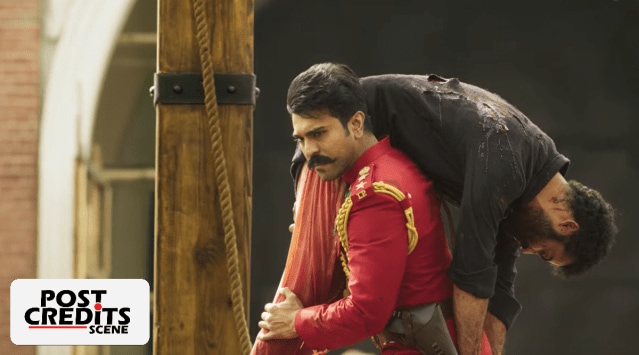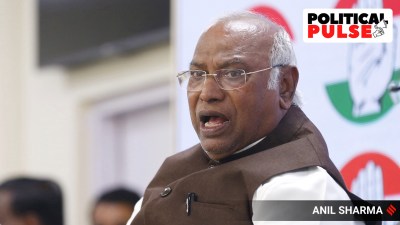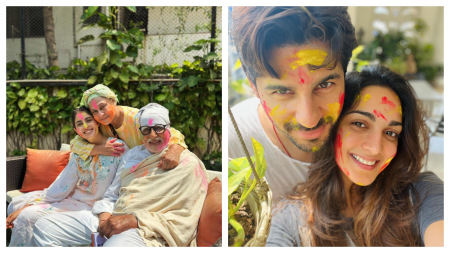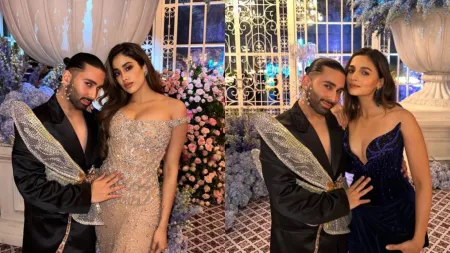- India
- International
RRR: SS Rajamouli’s epic tests the limits of believability, but nothing is as far-fetched as Ram Charan’s character arc
Post Credits Scene: SS Rajamouli's RRR offers plenty of spectacle and rousing drama, but watching it at home--without the sound and fury to distract you--can reveal certain chinks in the film's armour.
 Ram Charan and Jr NTR in a still from SS Rajamouli's RRR, now out on streaming.
Ram Charan and Jr NTR in a still from SS Rajamouli's RRR, now out on streaming.Director SS Rajamouli’s maximalist ode to machismo, nationalism and male bonding, RRR pushes the boundaries of believability on a minute-to-minute basis, but nothing—no amount of CGI tigers, race-blind romance, and miraculous jadi-bootis—tests the limits of your good faith more than Ram Charan’s character, Alluri Sitrama Raju.
A largely fictional story about historical figures, RRR from its very first scenes makes no bones about the insanity that it has in store for audiences. It opens with three pre-title prologues in which we’re introduced to the two central characters, Charan’s Rama Raju, and Jr NTR’s Komaram Bheem. These are protracted action sequences that Rajamouli has designed purely to get you tuned to his wavelength. If you find yourself resisting, or questioning the logic of it all, then you’re probably going to be stranded for the next two-and-a-half hours, because what follows is more of the same, but dialled up.
Because they’re so well crafted, buying the heightened reality of Rajamouli’s film doesn’t require too large a leap of faith. I didn’t doubt for a second that Bheem could single-handedly take on a tiger, nor did I question Rama Raju’s ability to defeat hundreds (if not thousands) of men armed with just a stick and an unbeatable spirit. But I was genuinely bothered by what I was expected to forgive, especially when it comes to Rama Raju’s actions.
In his introductory scene, the character—a foot soldier for the British stationed in Delhi—volunteers to quell a concerning protest by apprehending the leader. After an extended fight sequence in which he fends off virtually everything thrown his way—at one point, he is struck on the back of his head with a rather large rock—Rama Raju secures the leader of the uprising and hurls him at the feet of his British captain, who is just as shocked by his invincibility as the rest of us.
I didn’t bat an eyelid when Rama Raju first took flight, but why, I asked myself, did Rajamouli write a scene—especially one this important—in which which his hero murders and maims innocent Indian protestors with clinical cruelty. Granted, he’s on a secret mission and his true motivations will eventually be revealed—this was never in doubt, by the way—but surely there could have been a better way to communicate his dedication to the (secret) cause? Surely a God-like being such as himself, endowed as he is with the power of flight, could have found a way to secure his target without harming his fellow countrymen first?

He’s obviously guilty about what he’s forcing himself to do, when he pounds a punching bag immediately afterwards, but this scene doesn’t minimise the magnitude of what the movie has just shown us. He would’ve been equally guilty even if he’d captured his target without inflicting violence upon anybody. He would’ve been wrestling with the same feelings of betrayal, and the movie would’ve gotten its point across.
To be clear, Rama Raju isn’t meant to be a villain or an antihero; this is someone that the movie wants us to sympathise with, a character whose journey we are meant to feel emotionally invested in. So, when he dismantles the protest on his own, we are meant to cheer him on. This isn’t a redemption tale; Rajamouli is actively trying to justify Raju’s actions by dangling the promise of an explanation later. To understand just how off-putting this is, try to replace Rama Raju with Bhagat Singh in your imagination.
But Rajamouli is merely testing the waters with this scene, because a little after the interval point, the movie suddenly turns into The Passion of the Christ for 20 excruciating minutes. Bheem is the Saviour, chained to a wooden pole in a public square, and in the context of this scene, Rama Raju is the Roman centurion instructed to lash him until he falls to his knees. By this time, the two have developed a brotherly bond, to the point that Bheem has even declared that he values their friendship more than life itself.
So, when Rama Raju beats his friend to a bloody pulp, and increases the intensity of the punishment by switching to a ‘thorned’ whip after Bheem refuses to yield, a shot of a single teardrop dramatically trickling down his eye doesn’t cut it. Inspired by Bheem’s song, the public lashing inspires the gathered crowd to rise up in revolt, which, ironically, isn’t what Rama Raju had intended. But imagine if he had; it would’ve explained his behaviour and perhaps helped us sympathise with him a little more. Rajamouli routinely ignores simple ‘fixes’ such as this.
Instead, he allows the Komuram Bheemudo sequence to unfold in graphic detail for an unnecessarily extended period of time, and follows it up with a simplistic scene in which Rama Raju verbalises his feelings and expresses remorse for his actions. It is in this scene that we are finally given an explanation for his actions; we are told that his mission was to arm every rebel fighter with a gun, and that he had been scheming to ingratiate himself into the inner circle of the British high command all along. “It has never been clearer to me,” he tells a random guy, “All this while, I was prepared to sacrifice anything for our country. I thought that Bheem would also be one among them. But today I have realised, Bheem is not merely a sacrificial lamb, he is a volcano. I was under the impression that guns would bring us freedom, but Bheem inspired everyone with just a song.”
And no, just because this speech sounds like Rama Raju correcting his ways and learning the importance of ‘ahimsa’, that doesn’t mean it really is. Because moments later, Rajamouli unleashes another action sequence dominated by gun violence.
“The needs of the many outweigh the needs of a few,” Spock said in Star Trek II: The Wrath of Khan. And while his utilitarian philosophy can be filtered through Rama Raju’s perspective, you won’t catch Spock whipping Captain Kirk in an effort to get in bed with Khan.
Post Credits Scene is a column in which we dissect new releases every week, with particular focus on context, craft, and characters. Because there’s always something to fixate about once the dust has settled.
Photos
Apr 19: Latest News
- 01
- 02
- 03
- 04
- 05








































